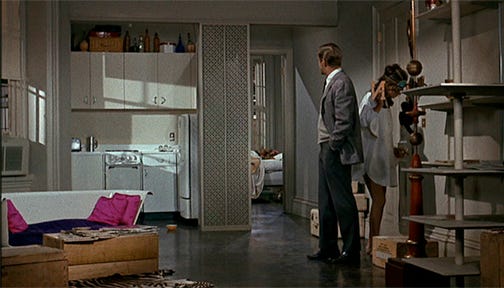So What, Who Cares (vol 3, issue 22) How companies with telecommuting policies come out ahead
Hello!
We all survived another week, which is something I no longer take for granted. How about you?
*
IBM made headlines in February by implementing a policy last seen at Yahoo in 2013: issuing a ban on telecommuting and informing workers they'd have to come to an onsite facility to work face-to-face with teammates. The kicker? Not everyone's assigned office was nearby, so some employees would be faced with the prospect of losing the telecommuting benefit and relocating for the job. As The Register reported:
Chief marketing officer Michelle Peluso told her US marketing troops they must work at "a smaller set of locations" if they want to continue with the company. Staffers have 30 days to decide whether to stay or go.
This means affected IBMers who telecommute, work at a smaller district office, or otherwise work separately from their team, will now have just a few weeks to either quit their jobs, or commit to moving to another part of America. The company's employee badge system will be used to ensure people do come into the office rather than stealthily remain remote workers.

Workers were to be assigned one of six offices, in locales ranging from Raleigh, NC, to San Francisco, CA. They had no choice in the location, and there was no guarantee of a salary adjustment if they were moving from an area with a lower cost of living to one with a higher cost of living. Further reporting revealed that IBM's edict affected 2,600 people in IBM's marketing department, plus an unknown number of workers in IT, procurement, and Watson-related groups.
Peluso's get-in-the-office move, which she touted as the "only one recipe I know for success," has led to a decline in employee morale. It also flies in the face of an established body of research on how telecommuting affects a company's performance over time.

So what? Telecommuting works for both employees and employers. For the former, the breaks from commuting mean they're more likely to be healthy and well-rested, and therefore more productive. For the latter, they're likely to get more hours out of their employees because telecommuters tend to sit there and work until they get stuff done. And telecommuters are more likely to put in a few hours even when sick -- so that's a net benefit to a company's bottom line because they're dealing with less absenteeism.
In addition to the time management benefits of telecommuting, there may be communications benefits. The Colorado Department of Transportation discovered that communication between coworkers actually improved, as did communication between employees and outside customers, once telecommuting was rolled out to some workers.
The rise of collaborative chat workspaces -- Slack, HipChat, Microsoft's Teams, etc. -- and the millions of dollars in funding they've attracted shows that there are businesses which have found a way to solve one of the big bugbears of telecommuting -- an inability to coordinate, brain storm or problem-solve with colleagues.
For a company to decide to forgo what is largely a low-cost benefit to employees and to decide that improved profits and decreased employee churn are no substitute for parking employees' bottoms in seats? One wonders what values are being prioritized by management and how that will reflect on a company's bottom line.
Who cares? Other than companies who keep a close eye on what workers cost them and want more bang for their buck out of their hires?

Two-job families do. If one partner's telecommuting and then gets the "Get up and move, or else face unemployment" edict, it's an economically and logistically fraught situation whether that worker stays with the employer who just said, "Move -- or else!" or chooses to remain in their current city of residence. Someone's going to be unemployed either way, and who knows for how long? At least 46% of two-parent households have both partners working full-time; another 23% have one parent working full-time and one working part time. That makes 69% of the parental workforce affected by one partner's sudden unemployment.
By the way, the definition of "family" is not limited to those who have children. Couples who have chosen to remain childfree comprise 29% of U.S. households. While the U.S. Census has not helpfully broken out stats for employment status by partner the way they do when there are children involved, the general trends are still clear: In over 50% of partnered households, both partners work. So a forced relocation affects both partners there too.
For the last thirty years, the majority of American workers have lived in families where they are not the sole earner. It's time for companies to recognize the reality of today's workforce: It's filled with people who are partnered to other workers. Employers who maintain the fiction that only one partner's job matters to a family are employers who are going to lose talent in the long run. Employers who look at thirty years of reality, recognize the stress outmoded employment culture puts on their workers, and adjust accordingly? They'll be the ones who have a future.
*

Your pop culture recommendation of the day: I am one of those people who believes in comfort re-reading and comfort re-viewing, and I have just finished a rewatch of the lamentably short-lived Don't Trust the B---- in Apartment 23 (available via Netflix or iTunes). Here's the thing I did not realize the first time through, because I had not yet seen Breakfast at Tiffany's when this show first aired: The layout in apartment 23 is a dead ringer for the layout of Holly Go Lightly's apartment in Breakfast at Tiffany's. (at right)

When you watch Don't Trust the B----, pay careful attention to where the door is, where the (magnificent) bookshelf is, how the kitchen's positioned relative to the living room, and where the windows are.
(I took a screengrab of those shelves, because they are amazing and I love them so much, I needed you all to see them too so we can sigh over how great they are.)
Since Chloe (the aforementioned b----) is really just the logical endpoint for Holly Golightly, it absolutely makes sense that her apartment would be a modern amplification of her predecessor's.
ANYWAY: The show is funny and it deserved six seasons and a series of movies, but I suppose we should all be grateful it didn't go that long because it released Krysten Ritter into the wild just in time for Jessica Jones.
*

